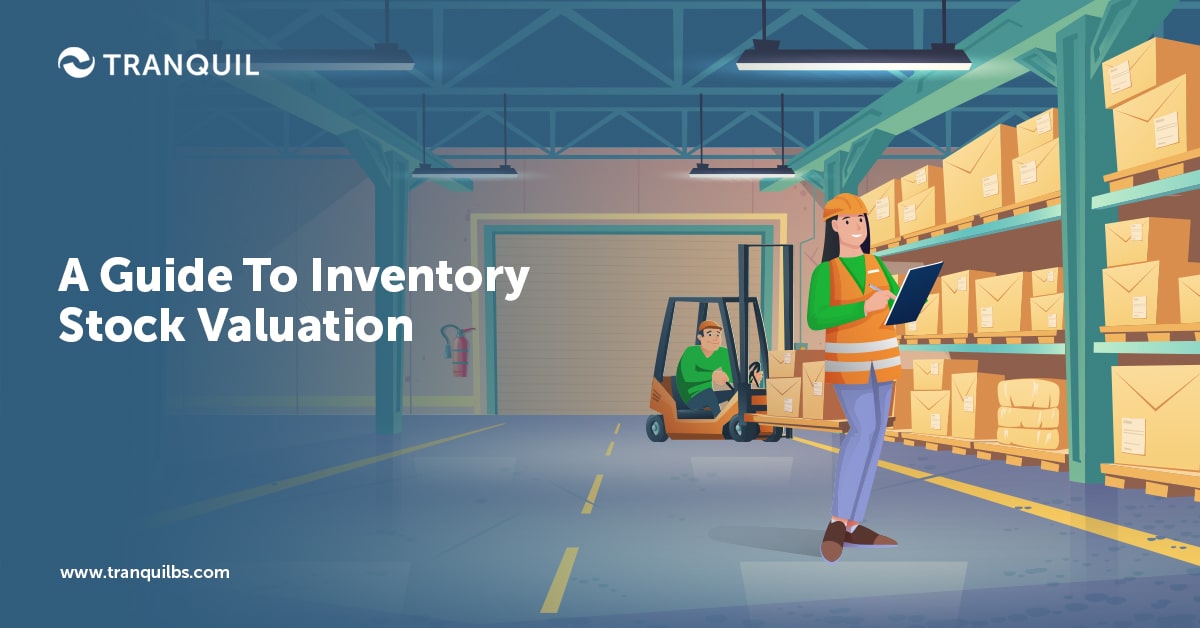
Inventory has numerous processes and activities associated with it, including inventory stock valuation.
It is an accounting process performed by businesses to establish the monetary value of the stock that lies unsold in the business at the time of preparing financial accounts.
It also helps in calculating the turnover ratio of your stock, which allows more effective planning of inventory/material purchases.
The inventory value is basically the cost you incurred in acquiring it, and to prepare it for sale.
Your inventory value gives you a clearer picture of the financial standing of your company as well.
ALSO READ : Physical Stock Verification and Its Advantages

At financial year end, a business is likely to have both finished products and work-in-progress along with raw materials.
It is imperative that you know what all of it is worth.
To create a product, you need several different materials and parts, but you also need people to put the product together, electricity, machine consumables, and so on.
This is one of the biggest components of inventory cost.
Direct labor includes wages paid to laborers assembling the products, insurance premiums paid for laborers’ lives, health, and compensation, contributions to pension, and payroll taxes if any.
ALSO READ: What is Inventory Aging?
These are the actual materials, accessories, and supplies used in production, including any residual materials that are discarded, broken, etc.
Usually, expenses that change with every unit manufactured is a direct expense.
Any expense incurred during manufacture in addition to the two above, are overheads.
Salaries paid to materials and production managers, QA specialists, etc. are indirect – as they are not directly manufacturing the product.
Other overheads are insurance, rent, utility bills, equipment setup, and maintenance expenses, depreciation of large equipment , minor tools, and so on.
ALSO READ: What is Inventory Reorder Point(ROP)?
The cost of shipping materials and other supplies into the business is the freight in expense.
In case the company offers free shipping of its products to its customers, there will also be a freight out expense.
Picking, packing, labeling – whatever work is needed to ready the product for delivery, is referred to as handling expense.
If any supplies used in manufacture are imported, you may have to pay import duty, and that is included in the cost of the product.
ALSO READ: Benefits of Cash Flow Analysis
The process is pretty simple:

ALSO READ: What is Stock Adjustment and Stock Transfer?
ALSO READ: What is Negative Inventory and How Can you Prevent it?
There are three main types of inventory stock valuation used – FIFO, LIFO, and WAC.
Let’s take a look at each of them in detail.

This method assumes that the products are sold in the order they are produced or procured.
So, the oldest products in stock are sold first.
It’s the most widely used valuation method as most business sell goods in the same order they were manufactured or produced.
ALSO READ: Inventory Management Trends to Know
A company bought 1000 units of a product at SAR 200 in one month.
They bought 500 units of the same product at SAR 250 in another month.
At the end of the accounting period, they had sold 800 units of the product.
This means they have (100-800) 200 + 500 units on hand.
Using FIFO, the first batch bought was sold, which means, the 800 units which were sold were from the first batch, valued at SAR 200.
200 x 200 = 40000.
500 x 250 = 125000.
The ending inventory or balance stock is worth 40,000 + 125,000 = SAR 165,000
ALSO READ: What is ABC Analysis in Inventory Management?
ALSO READ: What is Negative Inventory and How Can you Prevent it?
As you can imagine, this method is the exact opposite of the FIFO method, and assumes that the latest produced or procured goods are sold first.
If we take the same example as above:
A company bought 1000 units of a product at SAR 200 in one month.
They bought 500 units of the same product at SAR 250 in another month.
At the end of the accounting period, they had sold 800 units of the product.
So here, we assume that the last purchased products are sold first; which means, all of the 500 units in the second batch are sold, and 300 units from the first batch are sold.
ALSO READ: Challenges and Benefits of CRM
1000 – 300 = 700.
700 x SAR 200 = SAR 140,000
ALSO READ : Benefits of ERP for Accounting and Financial Management

This method takes the average cost of products purchased or produced in a period, and is used by companies that have no variation in their inventory stock.
A company bought 1000 units of a product at SAR 200 in one month.
They bought 500 units of the same product at SAR 250 in another month.
This means they have a total of 1500 units of the product, for which they paid (200,00 + 125,000) or 325,000 SAR.
The weighted average cost would be SAR 325,000 divided by 1500 units, or SAR 216.66 per unit.
At the end of the accounting period, they had sold 800 units of the product.
This means 700 units remain; the cost of this ending inventory is :
700 x 216.66 = SAR 151,662.
ALSO READ : Benefits Of Software As A Service
This method is followed to be able to track the exact cost of each item in the inventory, usually because they are all unique items.
Every single item is identified, marked, and tracked for this method to be successful.
This can be done manually or through electronic tags, scannable stickers with serial numbers etc.
ALSO READ: Keys To Make Project Management Success

Your business goals and the market environment will determine the best method for your inventory valuation.
We discuss below the ideal method for a few scenarios:
If you want to apply for a loan, it is good to maintain inventory to show as collateral; the higher the value, the happier your lender will be.
The closing balance value of your inventory is an important criteria considered by lenders.
So, you must use the method which will help you show the highest value.
If the prices of inventory have been rising, use the FIFO method, and the LIFO method if they have been falling.
ALSO READ: Key Steps for Successful Demand Planning
Profitable businesses can attract future investors, and keep current investors happy.
If the market is inflationary, the FIFO method will benefit you, but in a declining market, use the LIFO method.
To reduce tax liability, use LIFO method – on the assumption that market is inflationary.
ALSO READ: What is Demand Forecasting?
You can see how important stock valuation reports are; it may some cumbersome, but we have the ideal solution for you. Tranquil has a robust inventory management module that can automate and streamline this process, saving your time money, and effort. Schedule a demo to know more!